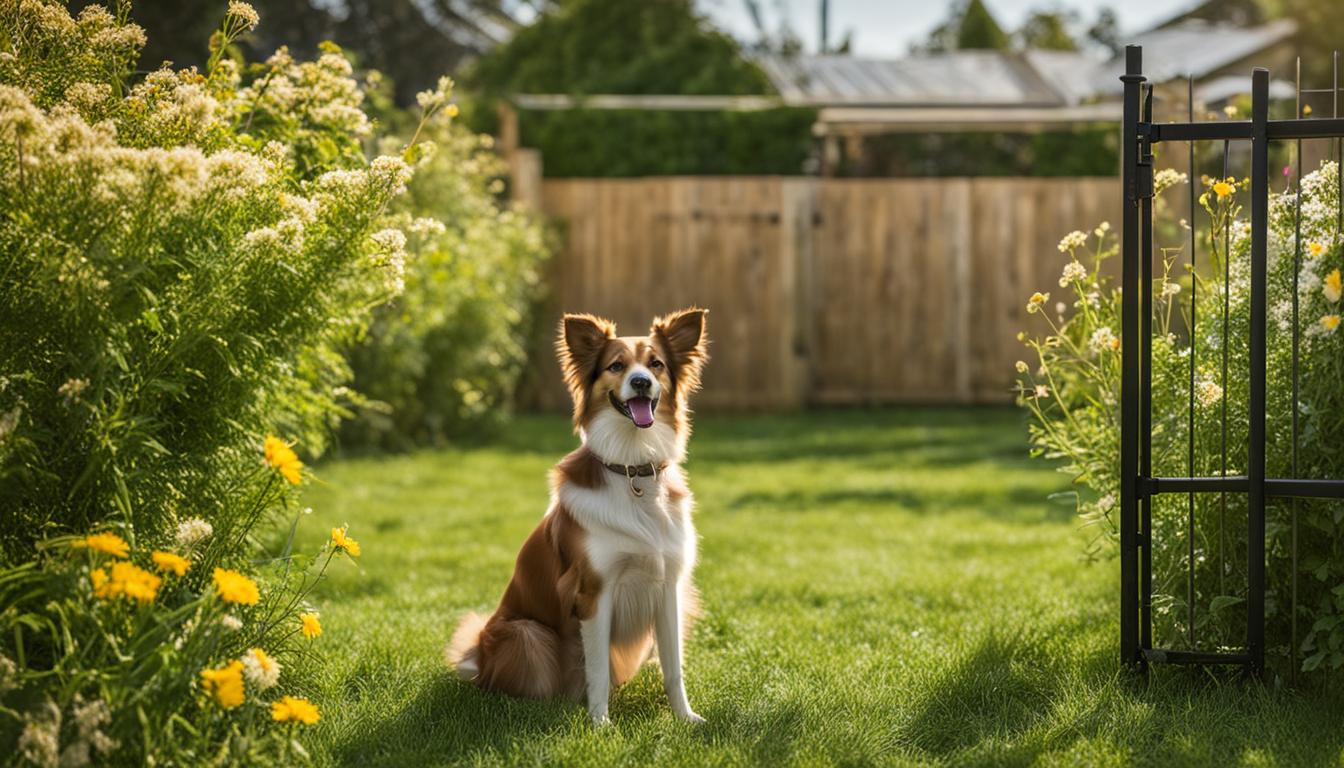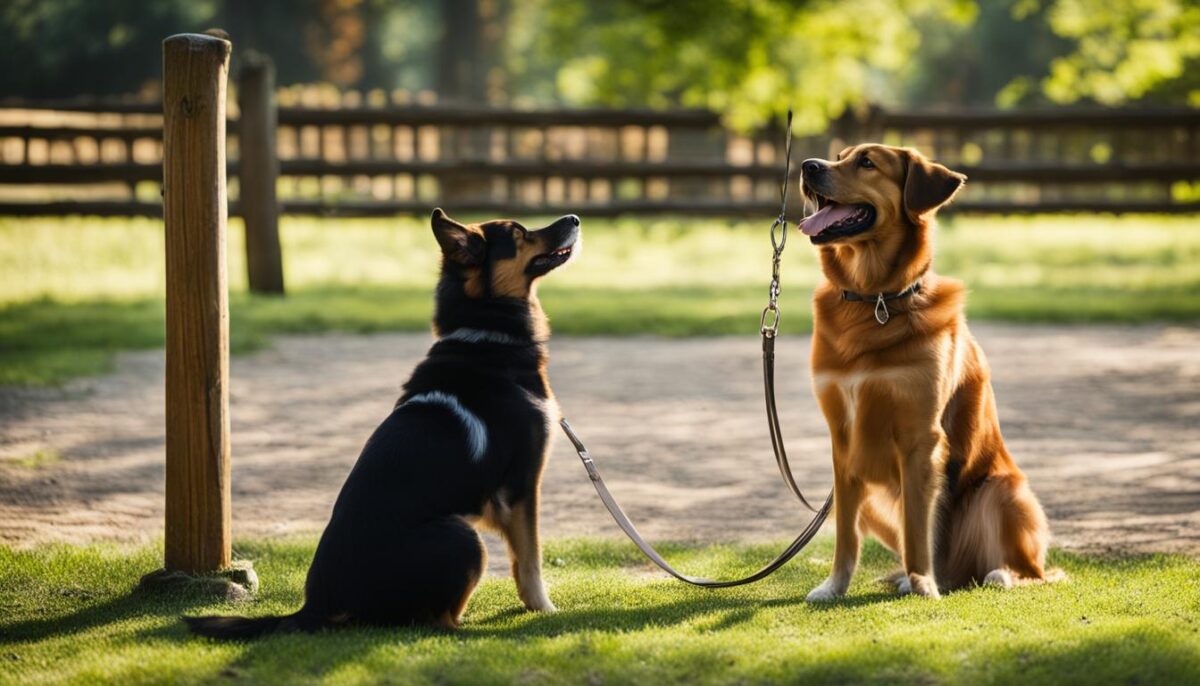As a caring pet owner, you want to keep your furry friend from harm. You love seeing them play outside, but if your yard doesn’t have a fence, it can be scary to let them roam. Dog safety is super important. That’s why teaching your dog to stay in your yard is a big deal. It’s like making an invisible fence with training. This is all about having fun with your dog while making sure they stay safe.
With outdoor dog training, you’ll use treats they can’t resist and practice every day. It may start with a leash, but soon they’ll know where they can and can’t go. And guess what? You can even use little flags to show your dog where the edges of the yard are. Think of it like playing a game where the goal is for your dog to stay inside the lines. It might take some time, but before you know it, you’ll have a dog that knows his boundaries, even with no fence in sight. This isn’t just about unfenced yard training, it’s about keeping your best pal close by and out of trouble.
Key Takeaways
- Teaching your dog to stay in the yard is all about keeping them safe.
- Use treats to make learning fun and rewarding.
- Practice every day — it’s key for your dog to learn the rules.
- Start with a leash, then later your dog can play without it.
- Use flags to show your dog where they can play.
- Training takes time, so don’t rush — you and your dog will get there!
Understanding the Importance of Boundary Training
Have you ever seen a dog running free and having fun in a big yard? It looks great, doesn’t it? But imagine if that yard didn’t have a fence. There could be problems, like the dog running into the street or going into places it shouldn’t. That’s why boundary training is a big deal, especially if you live in the countryside or have a big yard.
For our furry friends, knowing where they can and can’t go is part of being safe. It keeps them from wandering too far and getting lost or hurt. It’s about property respect, too, just like when you know to stay out of your neighbor’s garden. You’re teaching your dog the same thing – to mind their own space and not go into others’ without permission.
Why is this training a must? It’s simple: pet safety is a top priority. If you’re a pet owner living out where there aren’t many fences, like in a rural area, this training helps your puppy understand where home is. This way, they stay close by and are less likely to bother animals that might live nearby, like cows or chickens.
It sounds tough, but really, it’s all about being patient and practicing a little bit every day. If you help your dog learn day by day, they’ll get it. Using things like leashes and special flags can make it clearer to them where they shouldn’t go.
Here’s a simple chart to show why this training helps. Look at what happens when you teach your dog these good habits:
| Without Boundary Training | With Boundary Training |
|---|---|
| Dog may run into the street | Dog knows where it’s safe to play |
| Yard is not respected | Dog learns where its home is |
| Neighbors might get upset | Neighbors stay happy and pets are liked |
| Pets could bother farm animals | Dogs and farm animals can live peacefully |
So, for all the pet parents out there, especially those living with lots of space around, teaching your dog boundaries is a really important way to keep everyone safe and happy. It’s a little time every day, but it’s worth it. Remember, practice, patience, and a few helpful tools are all it takes!
How to Train a Dog to Stay in the Yard
Teaching your furry friend to stay in the yard is a big step in keeping them safe and happy. Let’s learn how to use tools like leashes, flags, and training tricks to help your dog know where they should stay and play. It’s like a fun game you both can enjoy!
Using a Leash for Initial Training
Leash training is the first part of teaching your dog to stay in the yard. This helps you control where your dog goes. A leash is one of the best dog training tools because it keeps your pet close while you both learn about the yard’s edges. Remember, patience in dog training is important. It’s a big job for both of you!
Establishing Boundary Lines with Flags
Bright flags can be used as boundary markers. They work like a visual “Do Not Cross” sign for your dog. Walk with your dog on a leash near these flags and teach them not to go past them. This helps build the dog behavior foundation for where the yard ends.
Mastering Commands and Recall Skills
Dog recall and training commands are super important. These tell your dog how to come back when you call them. Use tasty treats or a longer leash to practice this. It helps keep your dog safe even if they have off-leash freedom someday.
Gradual Transition to Off-Leash Training
After lots of regular training with a leash, you can slowly start practicing without it. First try this in a place where your dog does really well with listening to you. As they show they can follow the rules, let them roam a little more. Soon, they might not need the leash in the yard!
Ensuring Consistent Practice and Patience
Keep taking your dog to the same spots and reinforcement techniques like giving them rewards. All this practice helps them remember the rules every day. Controlling pet movement isn’t just about being the boss—it’s about caring and trust-building.
| Training Tool | Purpose | How to Use |
|---|---|---|
| Leash | To guide your dog | Keep them close and walk around the yard |
| Flags | Marking boundaries | Place around the edge of your yard |
| Treats | Rewarding good behavior | Give when they return to you or stay in the yard |
| Voice Commands | Teaching recall and control | Use words like “come” or “stay” consistently |
Remember, whether it’s playing fetch or just chilling in the grass, your dog staying safe in the yard means more fun for both of you. So grab some treats, plant some flags, and start training your dog today—you’ve got this!
Conclusion
When you take the time to train your dog to stay in the yard, you’re doing a great thing! It means you want your pet to be secure and happy. Remember, dogs like to know where they should go and where they should not. Using leashes, flags, and commands is like teaching them the rules of a game. And just like any game, practice is key. By practicing a little bit every day, you make sure your dog learns these important rules.
And training doesn’t just help your dog; it’s also good for you! Knowing your dog is safe means you can relax and not worry about them running off. This makes everyone – neighbors and people walking by – have a good day, too. So, it’s not just about having a happy dog owner, it’s also about having a happy community.
Last of all, always watch your dog when they are playing in the yard. This will help your furry friend remember the rules about staying safe in the yard. With successful dog training, you and your pet can enjoy lots of fun times outside together. By working together, keeping at it, and staying patient, you and your dog can do great things!
FAQ
Why is it important to train my dog to stay within an unfenced yard?
Training your dog to stay in an unfenced yard is crucial for your pet’s safety and your peace of mind. It helps prevent your dog from wandering onto roads or neighboring properties, which could lead to accidents or other dangerous situations.
What are the basics of boundary training for dogs?
Boundary training involves teaching your dog to understand and respect the limits of the area you’ve deemed safe, such as your yard. Using consistent cues, rewards, and sufficient repetition, your dog will learn where they can and cannot go.
How can I use a leash to train my dog to stay in the yard?
Start by using a long leash to guide your dog around the yard’s boundaries. This establishes a physical connection and helps your dog learn the safe area’s limits with the security of knowing you’re in control.
How do flags help with establishing yard boundaries for my dog?
Flags serve as a visual cue for your dog, marking the perimeter of the safe area. During training sessions, guide your dog to these markers and teach them not to cross this line, reinforcing their understanding of the boundary.
Why is a reliable recall critical in boundary training?
A reliable recall ensures you can call your dog back to you if they get too close to the boundary or are in a potentially unsafe situation. It’s an essential skill for maintaining control and ensuring your dog remains within the designated area.
What should be my approach to transitioning my dog to off-leash within the yard?
Transitioning to off-leash time should be done gradually and only once you have confidence in your dog’s obedience to boundary training and recall commands. Always start in safe, enclosed areas and keep a leash nearby for safety.
How often should I practice boundary training with my dog?
Consistent, regular practice is key to success. Aim for daily training sessions, keeping them short and positive, to reinforce the boundaries and encourage your dog to respect them.
What are some effective reinforcement techniques for boundary training?
High-value treats, positive praise, and playtime are excellent ways to reward your dog for staying within the boundaries. Consistent, positive reinforcement strengthens the behavior you want to see.
How do I ensure my dog doesn’t wander off while I’m not looking?
Consistent boundary training, supervision, and engagement with your dog while they’re in the yard can discourage wandering. Providing adequate mental and physical stimulation will help keep your dog content within the safe area.
Can boundary training be successful in rural areas with different challenges like wildlife or livestock?
Yes, boundary training can also be successful in rural areas, but it may require additional considerations, such as higher levels of supervision, reinforcing training against distractions, and possibly incorporating specialized training if your dog will be around livestock.

